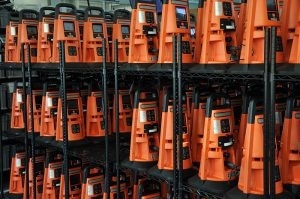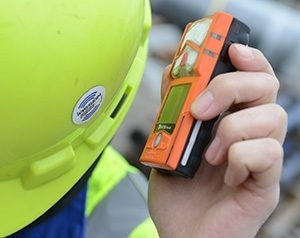
Making sure that the workplace is supplied with the right type and number of gas detectors and other safety equipment is vital to ensuring a safe working environment. The criterion here should not be restricted to the price of the unit concerned, important as this is, but should take other factors such as dependable performance, long life, the ability to withstand harsh conditions and convenience of use.
The cost of using and maintaining the equipment in the long run should also be considered as part of the ownership cost. How is it possible to reconcile budget requirements with the need to buy the best safety equipment for plant employees? One way is by carefully choosing gas detectors with only those features that are necessary and which allow a smaller number while maintaining top efficiency.
For instance, if there are 450 employees in the field in one particular company, and if all of them are exposed to a hazardous area containing hydrogen sulphide (H2S) for at least a part of the time, like once a week or so, an H2S detector is required.
If in addition the workers also need to climb into cramped spaces from time to time, the safety requirement would be that the individual worker can maximize safety precautions by wearing a four-gas monitor for about a fourth of the working hours, to cover both the exposure risk for H2S and the entry into narrow cavities.

Area monitors with long run times help to minimize the need for more instruments in your pool of “spares.”
In such situations, the safety manager is often responsible for servicing and repairs to gas detectors, among all the rest of the safety equipment, as and when he gets time. Depending on the workload, other priorities may dominate so that one instrument may stay on the service list for weeks to months.
In addition, the safety manager also has to keep track of the instruments in relation to their owners. Generally, this is accomplished by keeping a spreadsheet filled with the names and instrument serial numbers. Since manual updating would take too long, each employee gets one gas detector, and is supposed to report any issues with the instrument to the supervisor, in which case it is changed for another.
This of course means the serial numbers are now different from those on the spreadsheet, making it unreliable. Another instance might be if a detector is issued by another employee in the absence of the safety manager so that it remains for him to find out which instrument was issued as and when he has time to do so.
Faced with this situation, the company may buy about 500 standard four-gas detectors, 450 for each of the field workers and 50 as reserves in case any of the workers return their equipment for repairs or downtime occurs due to some other reason.
However, there are some ways to reduce the number of gas detectors required as well as saving money in such a setting:
Using a service program that is responsive and replaces equipment as needed with promptness removes the need for keeping reserve instruments. As an illustration, consider that a service provider is notified of a failed calibration test for a gas detector, and can replace it in a few days.
There is then no reason to buy spare instruments while the defective detector languishes for days awaiting repair and troubleshooting procedures. Using information technology for smart maintenance involves the adoption of software tailored for managing gas detection technology.
This allows the automatic notification of the service provider if a detector fails a calibration, as well as enabling equipment status, so that any signs of wear and tear or suboptimal performance may be met by immediate troubleshooting or servicing, before the trouble becomes worse.
For instance, it helps identify if a sensor is getting too old for use, so that even before the final diagnosis is sealed a replacement before the old one finally breaks down. It can also keep a watch on the use of the equipment so that it is possible to tell if any misuse or abuse is occurring – for instance, if bump testing is being done every day as it should.
If this is skipped, the user will not be able to rely on its readings, as nobody can tell if the monitor will alarm in response to the presence of a toxic or combustible gas. Thus, the convenience of automated gas detector management by appropriate software is complemented by the assurance that the equipment is working as designed at all times.
Using advanced technology to assign users for the instruments also helps keep track of who has what, by instance, by using smart tags which instantly link the user’s name to the instrument number, avoiding the need for manual updates to be made. The use of electronic records also reveals the traces of each instrument and makes it a snap to manage the instrument fleet without having to assign each one individually.
Just being able to see how many instruments are needed at a given time based on the people who will be using them helps to trim the number considerably. Using gas detectors built for durability is another important step in reducing the cost of the instrument pool.
A gas detector should be able to function well in rugged surroundings, without breaking down, as this helps reduce the time and the number of people needed to check the instrument health, repair them, and order replacements.
These four steps are the most important things a company can do to reduce its instrument fleet to what is strictly necessary. Reserves are thereby eliminated as they are sure of having a faulty instrument repaired within a few days of any issue with its working.
Durable detectors avoid downtime for maintenance, and if smart user assignment is adopted, the fleet can be cut down to fulfill the need of the actual number of users at any given moment rather than the total number who will be exposed over the whole work period.
In the example above, this approach could cut the total instrument number down from about 500 to just 100, saving a lot of money as well as freeing the safety manager to actually focus on keeping safety measures at a premium and ensuring a safe workplace environment, rather than just managing to keep the instruments being used in the field up to par, and becoming bogged down in administrative tasks.
Thus, selection of the right safety equipment that can pare down the fleet size to the essentials is an unglamorous but extremely necessary task which can save both time and money for the company to a significant degree.

Gas detectors that allow users to be assigned on-the-fly by tapping the instrument to a hard hat tag can significantly shrink the size of the instrument fleet.

This information has been sourced, reviewed and adapted from materials provided by Industrial Scientific.
For more information on this source, please visit Industrial Scientific.